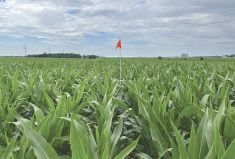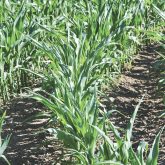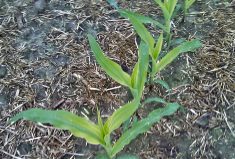David Bekkering knows a thing or two about corn, and given the size of his operation, it only makes sense. As farm manage er of TFS Expanse, knowing how it’s grown and turned into feed goes a long way to defining success for his operation.
Bekkering and his brother James run four Alberta feedlots with about 30,000 head of beef cattle. The largest feedlot feeds finishing and background animals while the other three are mainly backgrounding facilities. They farm about 4,500 acres, with a fairly even split between owned and rented land. James’s primary focus is on the feedlot while David looks after the crops and equipment.
“This year, we’re farming around 2,600 acres of corn, 600 acres of hay, 500 acres of seed canola, about 600 acres of wheat and 200 acres of pasture grass,” says Bekkering, who’s based at the operation in Taber. “We also have several custom growers who grow corn for us, which we harvest, and those acres can be silage or corn.”
Read Also

Could crop sharing be a viable option for your farm?
Crop sharing could be a good option for young and beginning farmers.
The 2022 growing season will be the third year they’ve grown Enogen corn — in 2020, they grew 180 acres of the traited hybrid, then 1,000 acres last year. This year all 2,600 acres were seeded to Enogen.
Across Canada, the hybrids were grown in Alberta, Saskatchewan, Manitoba, Ontario and Quebec. There were five hybrids ranging from 82 to 107 days to maturity. In 2023, Syngenta will add a 100-day hybrid to its lineup.
“My test plot included two hybrids the first year: one an 80-day and the other an 86-day, and a 50/50 split each with about 90 acres per plot,” says Bekkering. “Last year, I was somewhat limited by supply. Then this year, I got the full allocation of my supply and we had one of our feedlots using solely Enogen corn, and we noticed significant cost-of-gain improvements there.”
The Enogen hybrid trait came from the discovery of a transgene from a bacterium that produces alpha amylase, an enzyme that enhances the breakdown of starch into sugar and increases ruminal starch digestibility in cattle. As much as it benefits the feed quality and efficiency, it also reduces the amount of starch shed in the manure.
Unique feed process
At TFS Expanse, they steam-flake their harvested corn in a mill that raises the temperature to 138 C, preserving it in a steam chest at 98 to 99 C, then cooking it for approximately one hour before flaking.
“The difference between Enogen and regular corn is its water absorption rate,” says Bekkering. “Its starch structure absorbs water a little faster, so we had to speed up the process of rolling, or lower the temperature that we rolled to. We imported our flaker mill from Texas because we found there was nothing similar in Canada that could produce the same quality.”
[RELATED] Farmtario: Silage growers urged to protect feed supply from Bt-resistant corn rootworm
He has a near-infrared (NIR) analysis machine to measure the degree of flaking relative to a starch number on the corn. When they flake it, they shoot for a 55 per cent starch availability value, which is unique in his region.
One of the other features that Bekkering has found in the past three seasons is that it’s a very sturdy plant for southern Alberta because its improved standability translates into better wind resistance.
“Unlike some other hybrids, because it’s a thick-stalked plant, it also has a little bit more frost tolerance,” he adds. “We’ve noticed that at the time of harvest, we can allow the grain to go to a harder kernel than our normal silages, because there was so much moisture in the stalks to offset our silaging process.”
There’s also less bottom-leaf die-off, so it tends to provide better weed coverage. And for yield, it has a fairly large cob — typically about five to 10 per cent larger than some of its competitors. Bekkering has also noticed the core is smaller in diameter compared to those hybrids that will have lots of kernels but a thicker inner core.
Confined to feedlots
The Enogen technology dates to 2005, when Syngenta began researching the technology. In 2011, it launched the hybrid in the U.S., with a focus on supplying corn to the ethanol industry. However, the notion of an end-user paying a premium, even for highly fermentable starch content, didn’t have appeal in the biofuels sector. In 2015, Syngenta changed its focus to the livestock business, specifically to ruminant feed.
“Improvements in feed efficiency can be looked at several different ways,” says Doug Helm, Enogen technical sales lead for Syngenta Canada. “In a dairy operation where production is capped, increased feed efficiency can mean milking fewer cows to achieve the same level of production. In a feedlot operation, you can achieve better production for the same amount of input or reduce your inputs or feed cost to achieve the same gains.”
Helm says the corn hybrid is unique to the livestock industry and needs to be contained to cattle operations at this time. Their stewardship guidelines allow producers to grow enough for their cattle operations while ensuring the product does not enter into the food-processing system. The hybrids are not currently available to grain producers unless they’re growing corn for a feedlot or dairy, and should not be delivered to a commercial feed mill or local grain elevator.

There are specific protocols for growing Enogen hybrids, including segregation and proper marking of bins and elevator controls, as well as proper cleanout procedures for trucks that may be hauling harvested corn to dairies or feedlots.
Helm concedes that some producers may not like the demand for cleanout procedures but notes they’re no different than with identity-preserved (IP) soybeans or glyphosate-tolerant crops.
“The (purple-coloured) grain tracking system allows producers to easily identify Enogen corn whether it be in a field, in a silo, a feed bunk or coming off a truck,” says Helm. “Along with the stewardship program, the purple kernels help ensure that Enogen corn ends up at its intended destination, in a feed bunk.
Feed efficiency
“These hybrids have been adopted from our most advanced genetics and producers can expect the same high yields they’ve come to know,” says Helm. “The great thing for livestock producers is that there are no additional inputs required to grow Enogen to receive the benefits to your livestock operation. They can expect to use the same fertilizer and weed control programs they would traditionally use on their operations.”
All Enogen hybrids available in Canada are Bt, glufosinate-tolerant and EZ Refuge and they also have coloured kernels as a means of identification and tracking.
Both Helm and Bekkering believe Enogen hybrids provide a unique sustainability story that also needs to be told. By improving feed efficiency on a cattle operation, Helm says the amounts of land, water and resources needed to produce a pound of beef or a litre of milk are being reduced. And Bekkering echoes that statement.
“If the animals produce at a higher efficiency, quantitatively we should be producing less methane,” he says, noting he’s seen and heard different estimates, but nothing that’s been stated officially. “There are people researching that right now.”
– This article was originally published in the January 2023 issue of the Corn Guide.
















